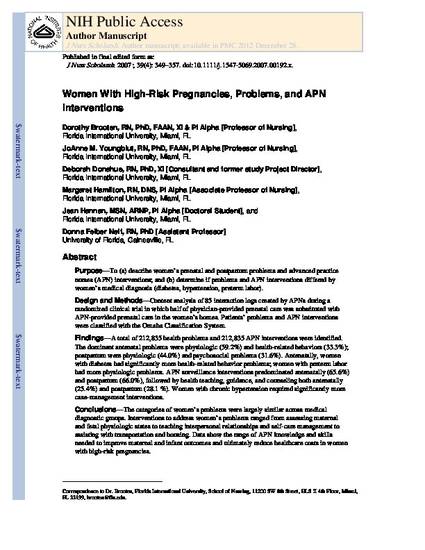
Purpose
To (a) describe women’s prenatal and postpartum problems and advanced practice nurses (APN) interventions; and (b) determine if problems and APN interventions differed by women’s medical diagnosis (diabetes, hypertension, preterm labor). Design and Methods
Content analysis of 85 interaction logs created by APNs during a randomized clinical trial in which half of physician-provided prenatal care was substituted with APN-provided prenatal care in the women’s homes. Patients’ problems and APN interventions were classified with the Omaha Classification System. Findings
A total of 212,835 health problems and 212,835 APN interventions were identified. The dominant antenatal problems were physiologic (59.2%) and health-related behaviors (33.3%); postpartum were physiologic (44.0%) and psychosocial problems (31.6%). Antenatally, women with diabetes had significantly more health-related behavior problems; women with preterm labor had more physiologic problems. APN surveillance interventions predominated antenatally (65.6%) and postpartum (66.0%), followed by health teaching, guidance, and counseling both antenatally (25.4%) and postpartum (28.1 %). Women with chronic hypertension required significantly more case-management interventions. Conclusions
The categories of women’s problems were largely similar across medical diagnostic groups. Interventions to address women’s problems ranged from assessing maternal and fetal physiologic states to teaching interpersonal relationships and self-care management to assisting with transportation and housing. Data show the range of APN knowledge and skills needed to improve maternal and infant outcomes and ultimately reduce healthcare costs in women with high-risk pregnancies.
Available at: http://works.bepress.com/joanne-youngblut/62/

Author Accepted Manuscript.
The publisher's final edited version of this article is available at J Nurs Scholarsh